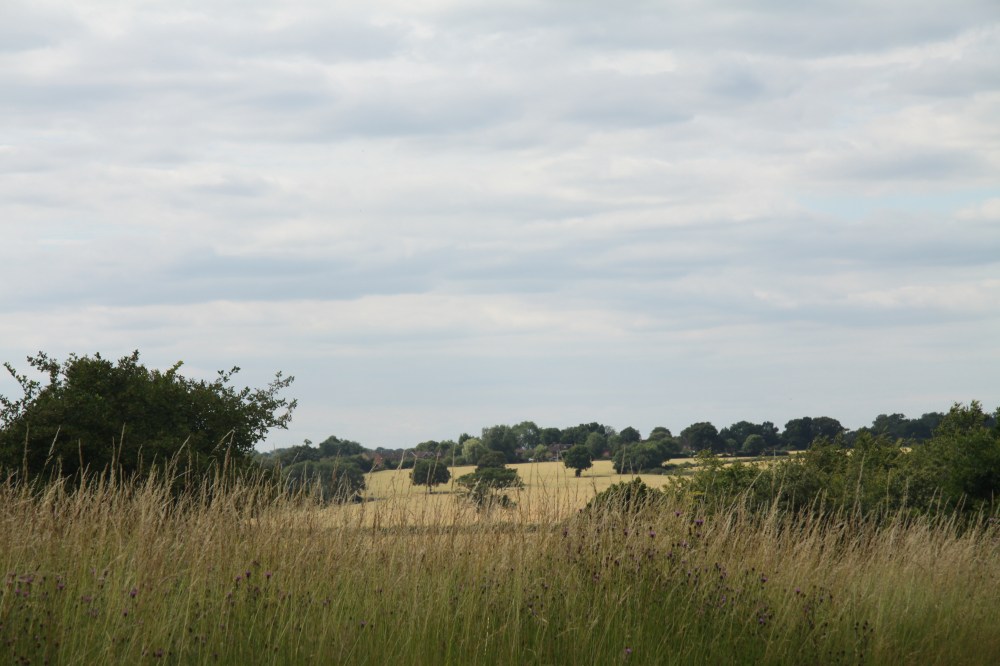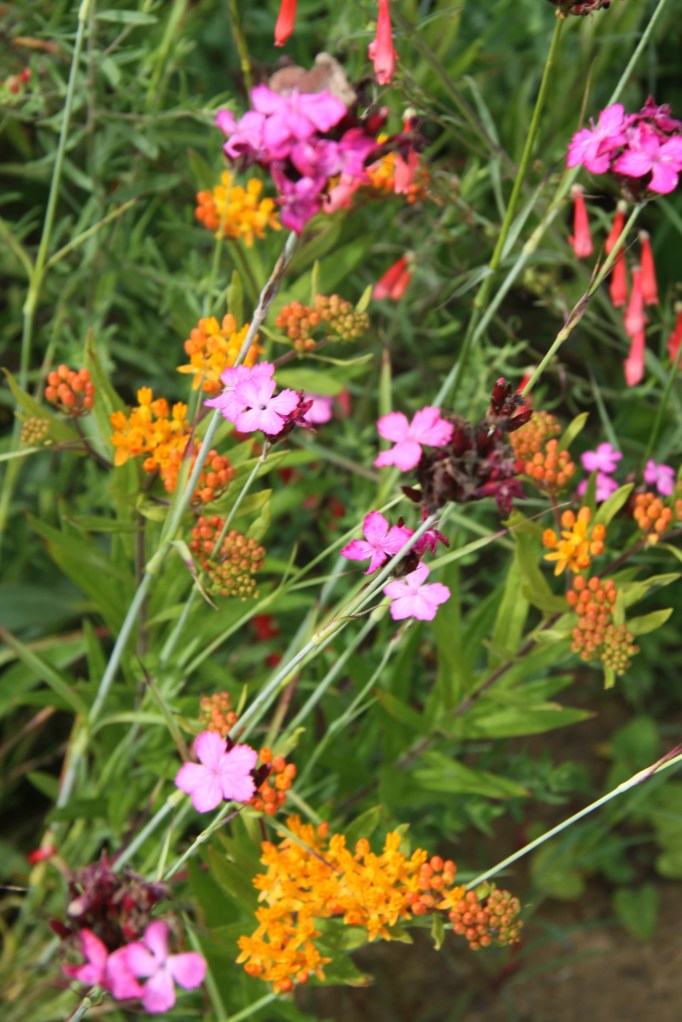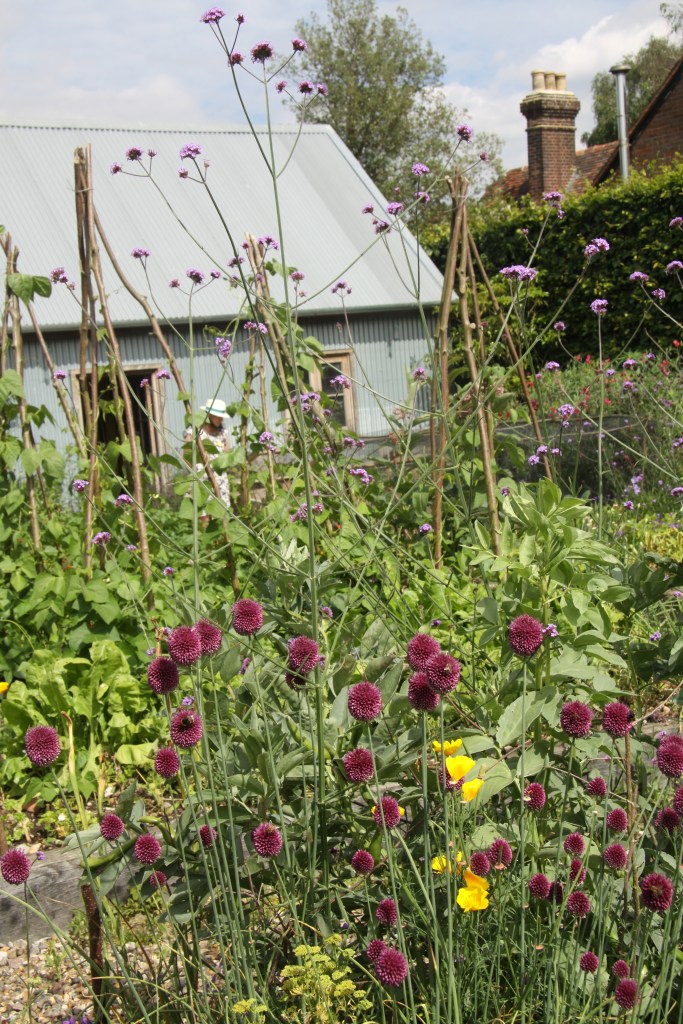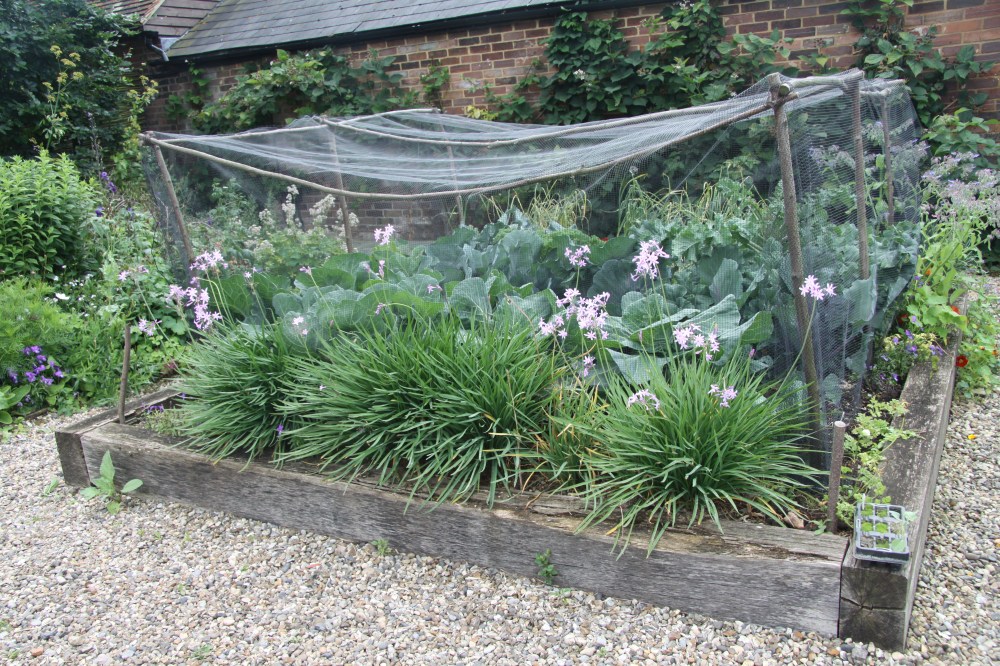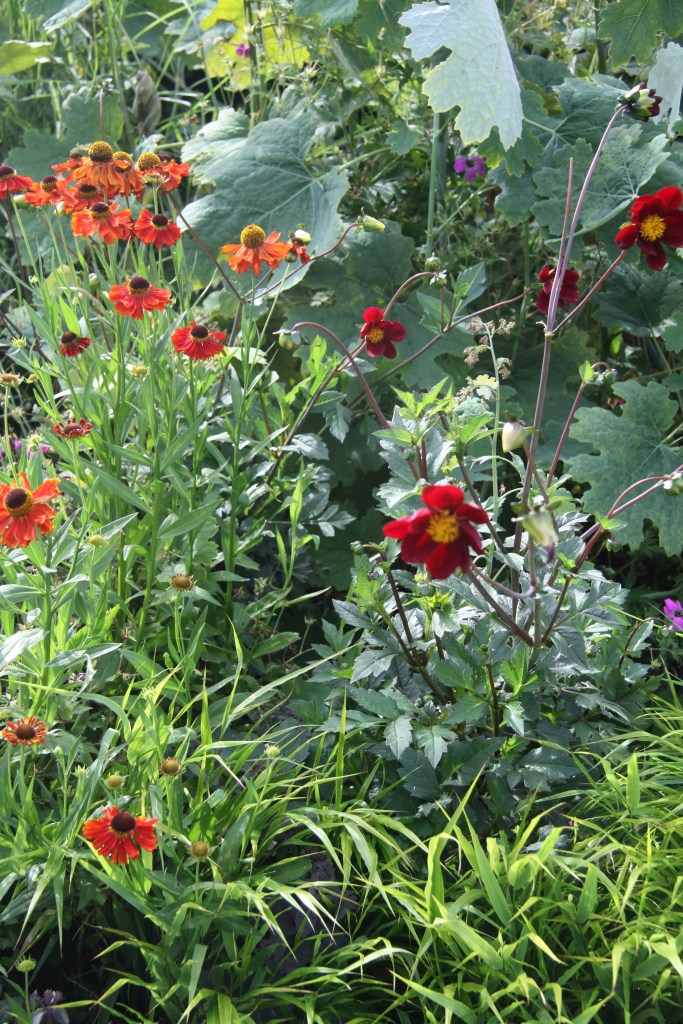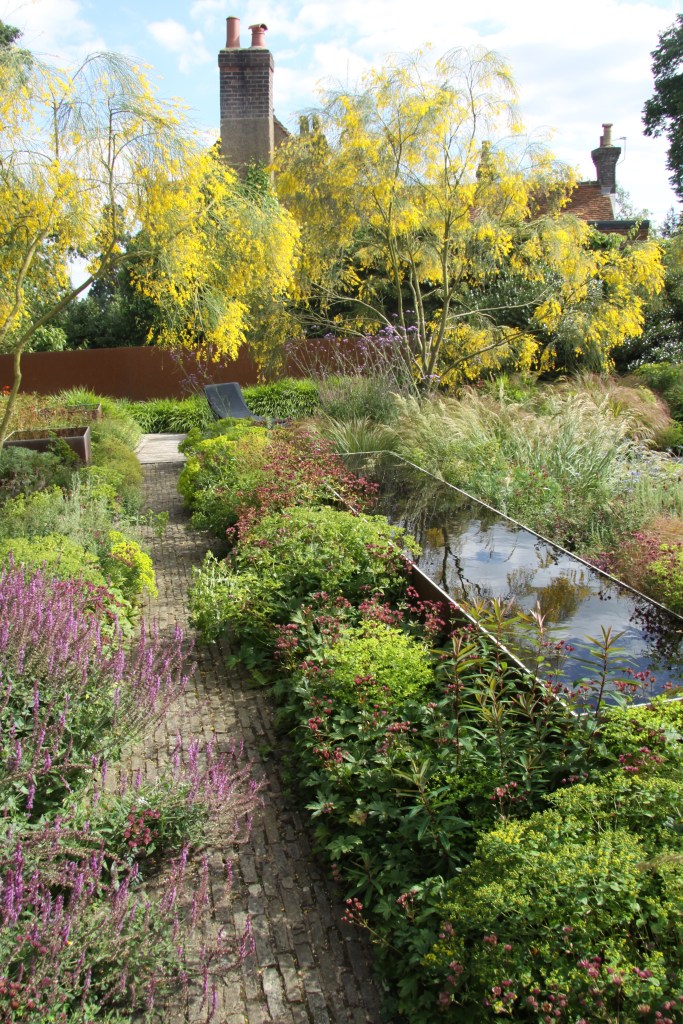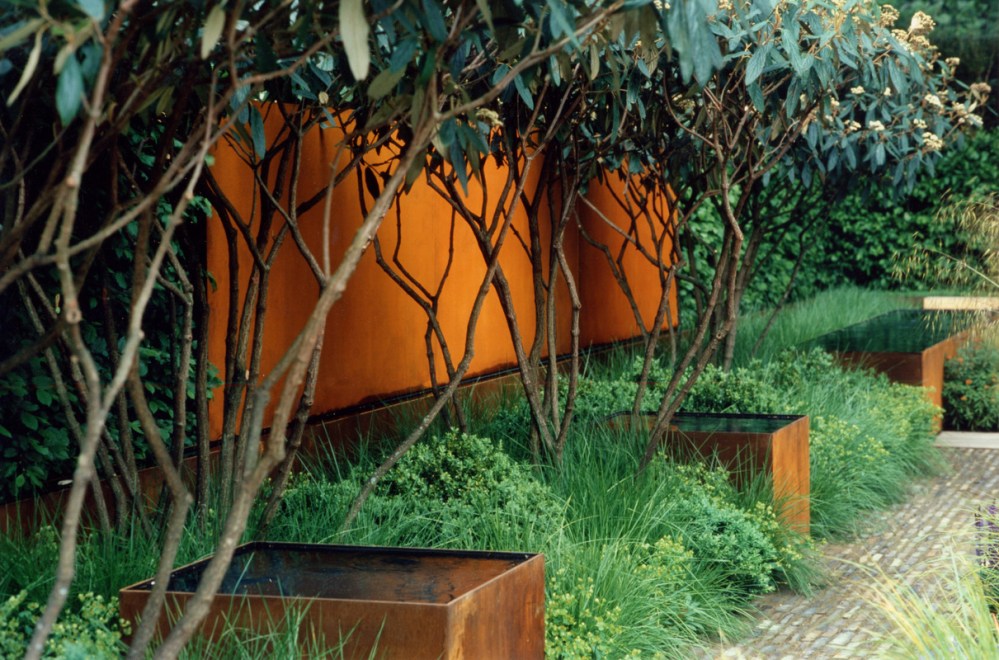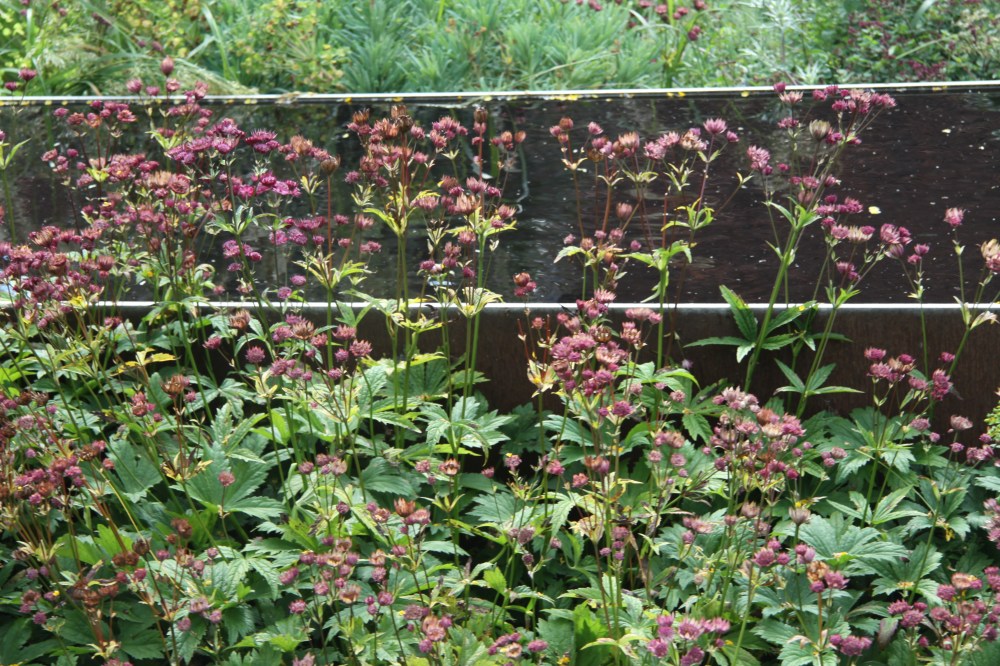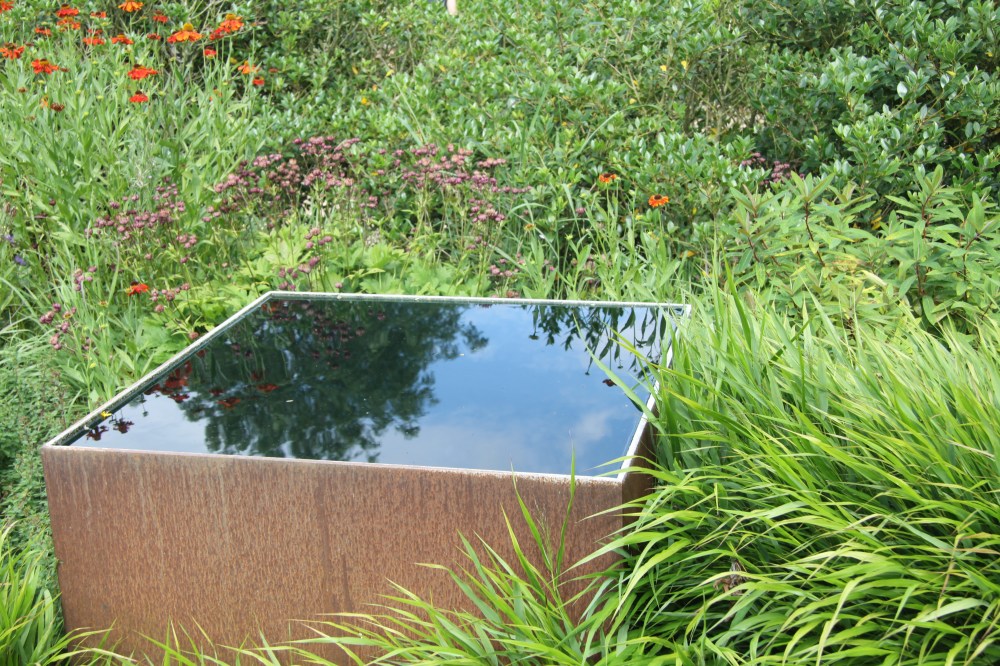(AND A HOUSE TO TOAST YOUR TOES IN)
 Cercidiphyllum japonicum, brilliant and toffee-scented at the entrance to the Walled Garden on the Cambo Estate, Fife
Cercidiphyllum japonicum, brilliant and toffee-scented at the entrance to the Walled Garden on the Cambo Estate, Fife

Crocosmia x crocosmiiliflora ‘George Davison’ with Colchicum ‘Lilac Wonder’, Herterton House, Northumberland
It is early October and we are finally travelling up the M1 to deposit one son at Durham University and visit his twin brother at St. Andrews, another long 175 miles further North.
 The road North, October 4th 2015
The road North, October 4th 2015
We pass Hatfield House, where only the day before at the Garden Museum Literary Festival I had fallen for the avenue of glowing storybook medlar trees laden with fat yellow quince:


 Medlar and Quince trees, laden with fruit, Hatfield House
Medlar and Quince trees, laden with fruit, Hatfield House
Deep in the car boot, under duvets and trumpets and carrier bags of cereal and chocolate bars, I have not forgotten the book that has recently taken over my life, my study, my entire approach to making a garden, (and indeed a home): Frank Lawley’s inspiring ‘Herterton House and a New Country Garden’ newly published by Pimpernell Press.

Frank and his wife, Marjorie have spent forty years steadfastly creating a personal, multi-layered garden and a deeply comfortable home out of an acre of Northumberland and a dilapidated stone barn – the whole of which is rented from the National Trust. Frank’s story of the evolution of Herterton is a book to be read in so many different ways – it is a rare and intoxicatingly honest autobiography of a life stretched to great things by industry and imagination, it is an illuminating history of gardening covering the still rather veiled period of Post War Britain and the second half of the Twentieth Century, and it is a precious practical guidebook, manual even, taking the reader with extraordinary thoughtfulness and generosity through every step of the creation of the garden and house.
I am inspired by the couple’s decades of hard work. ‘It is remarkable to discover what can be done if it has to be done and how absorbing it is to do it’ writes Frank, describing his approach to their disciplined year-round approach to developing the house and garden. ‘Holidays have not featured’: there is outdoor work when it is light and needlework, seed sorting or researching until nine ‘oclock at night. But the hard work is always driven by an enormous sense of satisfaction and pleasure in what has been created. The couple met as art students in Newcastle – ‘while Newcastle had many Chinese restuarants there was only one Jazz club – and there was Marjorie!’ – and they spent their first few years together in Marjorie’s home territory of the Wallington Estate, which had been the vibrant, generous home of the socialist MP, Charles Trevelyan, where learning about design, plants, furniture, porcelain was to be had if you opened your eyes to it.
As Frank Lawley describes the avid way the pair went about scanning the world around them, trying to work out what sort of world they might want to create for themselves, you cannot help learning too. They fall almost accidentally into a love of gardening – knowing that there must be something beyond a strip of lawn and a straight border for flowering plants, but genuinely not being sure what. They hitchhiked their way around Britain – Frank points out that Post War Britain was a perfect time for free travel, the generosity of drivers an enduring legacy of a system that evolved for off-duty soldiers to find their way home – and they read books on garden and architectural history painstakingly ordered from the mobile library. As they visit Great Dixter and Sissinghurst, they look hard and take notes (of Dixter: ‘when we looked inside the house …the furnishing was perfect and masterly’). Alongside the once in a lifetime visits, they drink in the wisdom of books by Nathaniel Lloyd (‘The History of the English House’ (1931) and ‘Topiary, Garden Craftsmanship in Yew and Box’ (1925)) and Ralph Dutton (‘The English Garden’ (1937) and ‘The English English Country House’ (1936)). As I read about Herterton, a small pile of wonderful second hand books forms on my own study table in an attempt to keep up with the Lawleys:

 On visits to local churches and to Ely and Durham Cathedrals, Frank and Marjorie Lawley observe that church gardens ‘offered hollies and yews, sometimes beautifully clipped … and that they were often ‘surrounded by reassuring stone walls.’ The great step forward – ‘perhaps our greatest discovery’ came when they visited the Elizabethan Anne Hathaways’ Cottage and Gardens and Mary Arden’s House at Stratford-upon-Avon. At Anne Hathaway’s cottage ‘the garden planting was unsophisticated, here were the daisies, thrift and pinks we knew. The house border had clipped yews and ivy …glorious furniture inside …pieces of vernacular character’ which ‘all looked so comfortably at home.’ At Mary Arden’s house they were delighted to see how the box hedge ‘bulged and spread, denying any entry by path’ and the interior of the house struck them both deeply ‘you could have toasted toes there’. Crucially they had discovered that ‘making small houses and gardens come to life seemed important’ and, despite the huge challenges of money, labour, exposed situation, this discovery, as well as a joint life-long love of the notion of home expressed in WInd in the Willows, propelled them forwards.
On visits to local churches and to Ely and Durham Cathedrals, Frank and Marjorie Lawley observe that church gardens ‘offered hollies and yews, sometimes beautifully clipped … and that they were often ‘surrounded by reassuring stone walls.’ The great step forward – ‘perhaps our greatest discovery’ came when they visited the Elizabethan Anne Hathaways’ Cottage and Gardens and Mary Arden’s House at Stratford-upon-Avon. At Anne Hathaway’s cottage ‘the garden planting was unsophisticated, here were the daisies, thrift and pinks we knew. The house border had clipped yews and ivy …glorious furniture inside …pieces of vernacular character’ which ‘all looked so comfortably at home.’ At Mary Arden’s house they were delighted to see how the box hedge ‘bulged and spread, denying any entry by path’ and the interior of the house struck them both deeply ‘you could have toasted toes there’. Crucially they had discovered that ‘making small houses and gardens come to life seemed important’ and, despite the huge challenges of money, labour, exposed situation, this discovery, as well as a joint life-long love of the notion of home expressed in WInd in the Willows, propelled them forwards.
I will leave you to read the step-by-step account for yourself and to enjoy Marjorie’s beautiful, utterly idiosyncratic, garden plans, as well as the garden itself when it is open again next spring. (The house is not open to the public, but the garden is open daily, 1.30 -5.30 pm, except Tuesday and Thursday, from April to September).


Two of the Marjorie Lawley’s hand drawn plans for the garden at Herterton
The slow pace with which this garden has evolved is extraordinary a world which is speeding along ever faster. Except for a number of more mature shrubs acquired in the 70’s from Matheson’s nursery which was sadly closing down, Marjorie has propagated everything for the garden herself. Who else will you find just beginning a garden of this this size and ambition, noting happily that ‘Marjorie had now a good collection of yew and holly seedlings, already six inches high’? Equally, when Frank very generously walks us around the garden on our pilgrimage forty years later, who else is likely to look at the roof of the yew ‘Sitouterie’, which is not yet joined at the top, and calmly advise that ‘it’s about to happen’ – meaning, on closer questioning, that the yew will join in two or three year’s time! (A ‘Sitouterie’, if you do not know, as I did not, is a sheltered place, usually created from a single shrub, with a space carved out at the base to ‘sit’ ‘out’ ‘in’).
The ‘nearly finished’ yew Sitouterie
It is so wet during our walk around the garden that all photos are, I am afraid, rather dank-looking iphone images, but you will, I hope, get the idea.
We enter the garden via a luminous arch of golden yew supported by a simple, beautifully clipped hedge of Euonymous – possibly ‘Silver Queen’ – with a stretch of the handsome male fern Dryopteris filix-mas ‘Cristata’ below and a pair of Spanish stone urns flanking the gate:
 The entrance to the Flower Garden – Golden Yew arch, Euonymus ‘Silver Queen’ and Dryopteris filix-mas ‘Cristata’ below
The entrance to the Flower Garden – Golden Yew arch, Euonymus ‘Silver Queen’ and Dryopteris filix-mas ‘Cristata’ below
You know from this simple beginning that you are in safe hands, that everything has indeed been carefully thought through and immaculately implemented. As Frank writes with such fond assurance in his book, ‘Marjorie has cooled everyone down before they walk under the golden yew arch into the flower garden’. But there is another layer to this simple combination – when the ferns are cut to the ground in midwinter they reveal a dense swathe of snowdrops to light up the entrance until the new fern leaves unfurl again.
The Flower Garden itself, even on this miserable day, is an extraordinarily deft, three dimensional tapestry of a garden which delights whichever way you look:




 The Flower Garden at Herterton, offering colour and texture , pattern and detail in every direction
The Flower Garden at Herterton, offering colour and texture , pattern and detail in every direction
From the outset the Lawleys’ plan was to use different forms of the ‘four native evergreen, yew, box, ivy and holly’ to ‘create different effects of colour and light’. The use of golden yew, is especially effective in their year-round mission to ‘create our own sunshine’. In most of the garden the use of different shades of green adds depth and subtle layerings, but occasionally the volume is turned right up. Here a flamboyant swathe of the yellow and green variegated ivy Hedera canariensis ‘Gloire de Marengo’ drapes itself against the house, contrasting dynamically with the exuberant fiery bronze autumn fronds of the Royal Fern, Osmunda regalis:
 Hedera canariensis ‘Gloire de Marengo’ and Osmunda regalis
Hedera canariensis ‘Gloire de Marengo’ and Osmunda regalis
But despite the years of preparation and careful planning, this assured combination of shape and form, colour and texture was not instantly achieved. As well as the Lawley’s determination to use clipped evergreens and beautiful stone paths and walls, they were keen to learn as much as they could about flowering plants and to work with colour in the garden in a painterly way. They had been inspired by the work of the gardener and writer about gardens, Margery Fish, and they had visited her and her home and nursery at East Lambrook Manor in Somerset, bringing back with them as many plants as they could carry.
But although Marjorie Lawley had found the way plants were used together in the garden at East Lambrook Manor ‘incomprehensible’ and ‘unkempt’, Frank was shocked when visitors who arrived as a result of the garden’s entry in the influential 1981 book, ‘The Englishman’s Garden’, also described Herterton as a ‘riot of colour’ The pair resolved ‘urgently’ to ‘compose in terms of colour too’: ‘you needed to have clearly defined sections with separate policies, and you should not have any repeat planting’. The revised Flower Garden found its natural – and brilliant – balance and their feeling that a relatively ‘tight’ formal structure might still leave ‘scope … for an element of frivolity to fit in’ has lived on successfully ever since.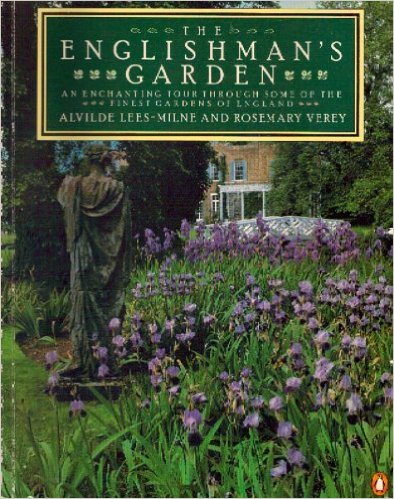
I am completely resolved to return to Herterton in midsummer to see Marjorie’s carefully graded Impressionist-inspired colour schemes in full flow, but for now, at the beginning of autumn, the balance between strong shape and brilliant colour, solid velvety background and fine texture is exhilarating enough.




 The Flower Garden, Herterton, with tightly clipped hedges a foil for late summer colour and a close up of the brilliant blue willow gentian, Gentiana asclepiadea
The Flower Garden, Herterton, with tightly clipped hedges a foil for late summer colour and a close up of the brilliant blue willow gentian, Gentiana asclepiadea
As well as the overall feel of the gardens, one of the many details I would love to witness in June is the trough and plinth pictured below which, densely planted with clipped ivy and two different kind of London Pride (the tiny Saxifrage cuneifolia within the urn and Saxifrage x urbium forming a mat below), have a subtle sculptural presence in autumn but will soften into a foam of pink in early summer:


 Trough and urn with clipped ivy and two forms of London Pride
Trough and urn with clipped ivy and two forms of London Pride
We walk through to The Physic Garden which is dominated by ‘one of the garden’s largest topiaries’ – a splendid storybook version of a weeping silver pear, Pyrus salicifolia ‘Pendula’. This is the ‘only topiary’ says Frank, calmly, ‘that needs to be cut twice a year – in early July and early October.’
 Topiaried weeping silver pear at the centre of The Physic Garden
Topiaried weeping silver pear at the centre of The Physic Garden
In this scented garden each bed is edged with soft, sculptural planting – thrift, Armeria maritima has a particularly successful plump, velvety quality – to contrast with the soft grey-pink ‘river sand’ underfoot.
 Close up of Armeria maritima used to edge some of the beds
Close up of Armeria maritima used to edge some of the beds
The house wall forms one of the sides of this courtyard garden and around the front door is a magnificent ‘Romanesque’ arch of the tiny ivy, Hedera helix ‘Spetchley’.
 The romanesque arch of Hedera helix ‘Spetchley’ around the front door
The romanesque arch of Hedera helix ‘Spetchley’ around the front door
Here again Frank and Marjorie Lawley have been inspiring beacons of patience – the ivy is so tiny and so slow growing that the arch has taken over thirty years to complete – the top edge was only joined up for the first time in 2013!
An open-sided stone barn forms another side of the Physic Garden. Here simple, silvered oak benches and salvaged medieval figures are joined by a rill of mounding wild ivy. The Lawley’s tried to grow ferns here but the position was too dark – the exuberant ivy is a clever solution.
 A wave of wild ivy softens the stone arches
A wave of wild ivy softens the stone arches
A favourite lichen-encrusted witch-hazel guards the exit of the Physic Garden. Frank Lawley writes beautiful about why it was chosen for this position – ‘for its mass of yellow flowers … a winter delight, always catching the sun or making it.’
 Lichen encrusted witchhazel
Lichen encrusted witchhazel
We visit the Formal Garden at the front of the house next. Again Frank writes beautifully of his original hope for the way this vibrant topiary garden might function – ‘a gesture of respectful hospitality…splashes of yellow may be the first indication to the traveller that there is a garden ahead.’
I am completely smitten by the mounded ‘bee skeps’ (based on the traditional domed basket-style bee hive). Frank says they are of ‘japanese box’ – perhaps Ilex crenata ‘Golden Gem’?
Beyond the field wall the landscape is ‘flamboyantly informal’ – I admire the way the wall is so thickly draped in ivy that the stone itself has disappeared and I love the view through the tightly clipped topiary and wooden gate to the soft grasses beyond:

 Views through to the wilder landscape beyond the garden
Views through to the wilder landscape beyond the garden
As we return to the house, Frank points out the bright-leaved thyme at the foot of the box hedge. In the book he captures the way ‘the luminous colour’ of this ‘ribbon of lemon-yellow, citrus-smelling, non-flowering thyme (Thymus pulegioides ‘Aureus)’… ‘is a pleasure in all seasons.’ It would be excellent to return in early spring to see the thousands of Crocus tommasinianus planted here, followed by a display of crown imperials in April and May ‘yellow and one end, red at the other, with the best a fine orange in the centre section.’ border edged with Thymus pulegioides ‘Aureus’, The Formal Garden
border edged with Thymus pulegioides ‘Aureus’, The Formal Garden
Finally, with the rain now soaking into us, we reach The Fancy Garden – a formal box parterre only planted in 1999 with a gazebo on the boundary. The idea was to have a garden with less colour (‘now we must return to green again’, writes Frank), as the garden meets the landscape. I had not understood before that the original function of a gazebo is to offer a view onto the surrounding countryside on one side and back into the garden on the other. The Lawleys learnt about this from Ralph Dutton and I am now learning from them. Frank Lawley’s design for the gazebo – as an echo to a slim elevation of the house – came to him in a ‘eureka moment’. The stone lavabo at the centre of the garden was hard won – you will have to read the book – and it is now believed to be Roman.
 View to the gazebo and Fancy Garden
View to the gazebo and Fancy Garden
 The box parterre in The Fancy Garden
The box parterre in The Fancy Garden
 The stone lavabo, Fancy Garden
The stone lavabo, Fancy Garden
But again, the idea of simple and green is not quite accurate. Frank explains that in the spring, the darkly serene yew ‘Sitouterie’ is invaded by hosts of aquilegia, then white martagon lilies and finally Campanula lactiflora. Now at the beginning of autumn, it is the end of the garden that gets the sun for longest, and Frank and Marjorie Lawley have naturally made the most of this late opportunity with vibrant combinations of apricot, salmon pink, magenta and lilac flanking the gazebo:
 Crocosmia crocosmilliflora ‘George Davison’ with Colchicum ‘Lilac Wonder’, ferns and pinks
Crocosmia crocosmilliflora ‘George Davison’ with Colchicum ‘Lilac Wonder’, ferns and pinks
Tritonia disticha subsp. rubroluce with another Colchicum, possibly byzantinum and Nerine bowdenii
Just occasionally, even Frank and Marjorie Lawley will take a few minutes off to sit on the covered bench in the open ground floor of the gazebo and enjoy a cup of coffee in this immaculate stone chamber:

Bench within the open ground floor of the gazebo
Through the lovely stone gateway there are the nursery beds where you will find ‘our last group of topiaries, mostly variations upon pyramids in yew and domes in silver holy which conceal our wooden sheds and a heap of sand.’ I would expect nothing less than a beautiful and ordered working area from this amazing garden. 
Stone doorway through to the nursery beds
We say a fond goodbye to Frank and I remember a line from his book which makes me smile because of its almost outrageous modesty: ‘one acre has been perfectly sufficient, for we have a very intensive style.’
Frank Lawley, Herterton, October 2015
We drive further North and arrive at St Andrews on the East coast of Scotland at dusk. The rain has faded away and the handsome stepped roof of the St Andrews Castle is silhouetted against a clear evening sky.
The Chariots-of-fire-famous West Sands is pale and silvery in the evening light and stretches out before us, simple and open:
 West Sands, St Andrews
West Sands, St Andrews
Our no. 1 mission for the next couple of days is naturally to bring (rather genteel) supplies to our student son – mattress topper, decanter, fine olive oil etc. – but we do manage to fit in a blustery rust-coloured walk along the coastal path picnicking on delicious smoked salmon and oat cakes from the East Pier Smokehouse in St Monans.

 The Coastal Path between St Monans and Elie
The Coastal Path between St Monans and Elie
As the rain returns we call in to the Victorian walled garden on the Cambo Estate. The approach is traditional and formal with an enormous, heavily draped, Vitis coignetiae turning a brilliant shade of crimson.
 Vitis coignetiae, The entrance to the gardens on the Cambo Estate
Vitis coignetiae, The entrance to the gardens on the Cambo Estate
For me, Cambo is synonymous with snowdrops – the estate has a National Collection of Galanthus and is well known for sending out high quality snowdrops ‘in the green’ in the spring. I have no idea, as we walk into the garden past a fantastically burnt-sugar scented Cercidiphyllum japonicum, that I am about to enter an end of season garden of such atmosphere and faded romance.
 Cercidiphyllum japonicum in the woodland garden en route to the Victorian Walled Garden, Cambo Estate
Cercidiphyllum japonicum in the woodland garden en route to the Victorian Walled Garden, Cambo Estate
As we peer in tentatively beyond the potting shed, we come upon a pair of gravel rectangles planted with elegant restraint – mauve Tulbaghia violacea, the white Galtonia candicans, and Gladiolus ‘Ruby’ (Papillo Hybrid) sing out in the low misty light. It is an idea that could be lifted from this faded two and a half acre Scottish garden and transplanted successfully in a much smaller domestic space.
 Gravel beds with Tulbaghia violacea, Galtonia candicans and Gladiolus ‘Ruby’
Gravel beds with Tulbaghia violacea, Galtonia candicans and Gladiolus ‘Ruby’
 Gladiolus ‘Ruby’ (papilio hybrid)
Gladiolus ‘Ruby’ (papilio hybrid)
Only later do I find out more about the history of the garden, how it is perhaps in the last fifteen years, when Lady Catherine Erskine hired the current Head Gardener, Elliott Forsyth, that the garden began to evolve from its former guise of productive rows of vegetables, dahlias – and even Christmas trees – into this hazy grass and colour-filled haven.
For now I enjoy the surprise and the simple intensity of the experience. This rich combination of scarlet-fruited apple tree underplanted with pale pink japanese anemone and the toad lily, Triscyrtris formosana:

 Apple tree underplanted with pink japanese anemone and toad lily
Apple tree underplanted with pink japanese anemone and toad lily
Rosy apples are met with the fading wands of Lysimachia ephemerum and crisp green apples look wonderful with the clean white of japanese anemone ‘Honorine Jobert’:

Apple tree with Lysimachia ephemerum Apple tree with Anemone japonica ‘Honorine Jobert’
Apple tree with Anemone japonica ‘Honorine Jobert’
A huge stand of the brightest orange red hot pokers glows in the water-filled gloom:
 Red hot poker and yellow achillea
Red hot poker and yellow achillea
 Red hot pokers taking centre stage.
Red hot pokers taking centre stage.
You cross the burn that runs through the garden via a beautiful, lichen encrusted ironwork bridge:

 Victorian iron bridge, Cambo Walled Garden
Victorian iron bridge, Cambo Walled Garden
Everywhere you turn there is something to catch the eye: rusty teasels soaring skywards from a sheet of yellow-green grass, the firework-white of Actea against the crumbling red brick walls and the rich dark red of rodgersia, its leaves edged in fast-moving claret.


 Teasel, actea and rodgersia in the Walled Garden, Cambo
Teasel, actea and rodgersia in the Walled Garden, Cambo
There are grasses everywhere, softly mound-forming or stormily turbulent in the pelting rain:

 Turbulent grasses, The Walled Garden, Cambo
Turbulent grasses, The Walled Garden, Cambo
The lilac-purple of Verbena bonariensis, the orange of the Kniphofia and the lavender-blue of the asters are electric in the low light:


 Electric colours of Verbena bonariensis, kniphophia, asters and salvia amongst grasses, The Walled Garden, Cambo
Electric colours of Verbena bonariensis, kniphophia, asters and salvia amongst grasses, The Walled Garden, Cambo
As we turn to leave the garden there is a brilliant combination of spiky palm tree, orange poker and ruby-pink Persicaria amplexicaulis against a backdrop of an ageing greenhouse and darkening sky.

 Palm tree, red hot poker and persicaria against darkening sky, The Walled Garden, Cambo
Palm tree, red hot poker and persicaria against darkening sky, The Walled Garden, Cambo
In the shelter of the courtyard, the lights are burning brightly and there are tables laden with little piles of just-dug-up already rooting snowdrops ready to be packed in moss and newspaper and sent out in the post now, in October, to flower in the coming spring.


 Piles of just-dug-up snowdrops, bowl of fresh moss, snowdrops wrapped in newspaper, ready to be posted out, Cambo
Piles of just-dug-up snowdrops, bowl of fresh moss, snowdrops wrapped in newspaper, ready to be posted out, Cambo
It is a cheering activity for a glowering day.
We call back briefly to see Frank Lawley at Herterton on our way home. It is still raining but lunch is over – and therefore it is time for work. Frank invites us to join a smilingly serious debate. ‘I almost got involved in making marmalade’ he tells us, ‘we live almost entirely on marmalade and we are facing something of a marmalade crisis. Do you think it is a marmalade day? No it’s a sowing day, I think.’
The road home















